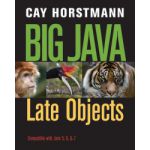Python for Everyone

DESCRIERE
Table of Contents
Chapter 1: Introduction
1. 1 Computer Programs
1. 2 The Anatomy of a Computer
1. 3 The Python Programming Language
1. 4 Becoming Familiar with Your Programming Environment
1. 5 Analyzing Your First Program
1. 6 Errors
1. 7 Problem Solving: Algorithm Design
Chapter 2: Programming with Numbers and Strings
2. 1 Variables
2. 2 Arithmetic
2. 3 Problem Solving: First Do It By Hand
2. 4 Strings
2. 5 Input and Output
2. 6 Graphics: Simple Drawings
Chapter 3: Decisions
3. 1 The if Statement
3. 2 Relational Operators
3. 3 Nested Branches
3. 4 Multiple Alternatives
3. 5 Problem Solving: Flowcharts
3. 6 Problem Solving: Test Cases
3. 7 Boolean Variables and Operators
3. 8 Analyzing Strings
3. 9 Application: Input Validation
Chapter 4: Loops
4. 1 The while Loop
4. 2 Problem Solving: Hand-Tracing
4. 3 Application: Processing Sentinel Values
4. 4 Problem Solving: Storyboards
4. 5 Common Loop Algorithms
4. 6 The for Loop
4. 7 Nested Loops
4. 8 Processing Strings
4. 9 Application: Random Numbers and Simulations
4. 10 Graphics: Digital Image Processing
4. 11 Problem Solving: Solve a Simpler Problem First
Chapter 5: Functions
5. 1 Functions as Black Boxes
5. 2 Implementing and Testing Functions
5. 3 Parameter Passing
5. 4 Return Values
5. 5 Functions Without Return Values
5. 6 Problem Solving: Reusable Functions
5. 7 Problem Solving: Stepwise Refinement
5. 8 Variable Scope
5. 9 Graphics: Building an Image Processing Toolkit
5. 10 Recursive Functions (Optional)
Chapter 6: Lists
6. 1 Basic Properties of Lists
6. 2 List Operations
6. 3 Common List Algorithms
6. 4 Using Lists with Functions
6. 5 Problem Solving: Adapting Algorithms
6. 6 Problem Solving: Discovering Algorithms by Manipulating Physical Objects
6. 7 Tables
Chapter 7: Files and Exceptions
7. 1 Reading and Writing Text Files
7. 2 Text Input and Output
7. 3 Command Line Arguments
7. 4 Binary Files and Random Access
7. 5 Exception Handling
7. 6 Application: Handling Input Errors
Chapter 8: Sets and Dictionaries
8. 1 Sets
8. 2 Dictionaries
8. 3 Complex Structures
Chapter 9: Objects and Classes
9. 1 Object-Oriented Programming
9. 2 Implementing a Simple Class
9. 3 Specifying the Public Interface of a Class
9. 4 Designing the Data Representation
9. 5 Constructors
9. 6 Implementing Methods
9. 7 Testing a Class
9. 8 Problem Solving: Tracing Objects
9. 9 Problem Solving: Patterns for Object Data
9. 10 Object References
9. 11 Application: Writing a Fraction Class
Chapter 10: Inheritance
10. 1 Inheritance Hierarchies
10. 2 Implementing Subclasses
10. 3 Calling the Superclass Constructor
10. 4 Overriding Methods
10. 5 Polymorphism
10. 6 Application: A Geometric Shape Class Hierarchy
Chapter 11: RECURSION
11. 1 Triangle Numbers Revisited
11. 2 Problem Solving: Thinking Recursively
11. 3 Recursive Helper Functions
11. 4 The Efficiency of Recursion
11. 5 Permutations
11. 6 Backtracking
11. 7 Mutual Recursion
Chapter 12: Sorting and Searching
12. 1 Selection Sort
12. 2 Profiling the Selection Sort Algorithm
12. 3 Analyzing the Performance of the Selection Sort Algorithm
12. 4 Merge Sort
12. 5 Analyzing the Merge Sort Algorithm
12. 6 Searching
12. 7 Problem Solving: Estimating the Running Time of an Algorithm
APPENDIX A THE BASIC LATIN AND LATIN-1 SUBSETS OF UNICODE
APPENDIX B PYTHON OPERATOR SUMMARY
APPENDIX C PYTHON RESERVED WORD SUMMARY
APPENDIX D THE PYTHON STANDARD LIBRARY
APPENDIX E BINARY NUMBERS AND BIT OPERATIONS
GLOSSARY
INDEX
CREDITS
•Greater emphases on problem solving with practical step-by-step illustrations of techniques that can help students devise and evaluate solutions to programming problems.
• A new visual approach that motivates the reader and eases navigation including photographs, step-by-step figures, syntax boxes, and example tables.
• New exercises from science and business engage students with real world applications of Java in different industries.
• An early introduction to object-oriented programming techniques, beginning in Chapter 2, provides extensive practice with objects and classes before students are asked to write their own classes.
• Horstmann’s clear explanations follow the beginner’s thinking process, providing examples and analogies, and anticipating where they may get confused or make mistakes.
• The Testing Track identifies and emphasizes the test-driven approach to programming.
Accesul clienţilor
-Top 10
-Cărţi noi
-- 344,25 leiPRP: 382,50 lei
- 1505,52 leiPRP: 1672,80 lei
- 546,21 leiPRP: 606,90 lei
Promoţii
-- 280,00 leiPRP: 350,00 lei
- 29,25 leiPRP: 45,00 lei
- 29,25 leiPRP: 45,00 lei














RECENZII